Lesson 18: Pictures and Text Wrapping
/en/word2013/headers-footers-and-page-numbers/content/
Introduction
Adding pictures to your document can be a great way to illustrate important information or add decorative accents to existing text. Used in moderation, pictures can improve the overall appearance of your document.
To insert a picture from a file:
If you have a specific image in mind, you can insert a picture from a file. In our example, we'll insert a picture saved locally on our computer.
- Place the insertion point where you want the image to appear.
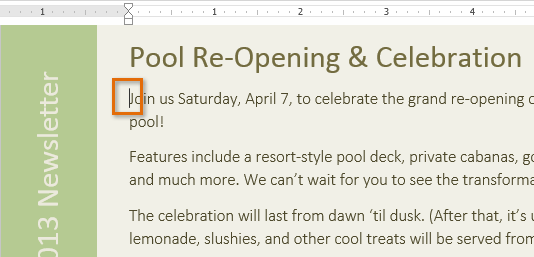 Placing the insertion point
Placing the insertion point - Select the Insert tab on the Ribbon, then click the Pictures command.
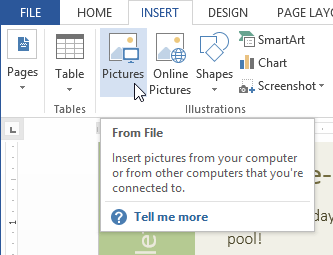 Clicking the Pictures command
Clicking the Pictures command - The Insert Picture dialog box will appear. Select the desired image file, then click Insert.
 Selecting a picture to insert
Selecting a picture to insert - The image will appear in the document.
 The inserted image
The inserted image
To resize an image, click and drag one of the corner sizing handles  . The image will change size while keeping the same proportions. If you want to stretch it horizontally or vertically, you can use the side sizing handles
. The image will change size while keeping the same proportions. If you want to stretch it horizontally or vertically, you can use the side sizing handles  .
.
 Resizing an image
Resizing an image
Inserting online pictures
If you don't have the picture you want on your computer, you can find a picture online to add to your document. Word offers two options for finding online pictures:
- OneDrive: You can insert an image stored on your OneDrive (previously called SkyDrive). You can also link other online accounts with your Microsoft account, such as Facebook or Flickr.
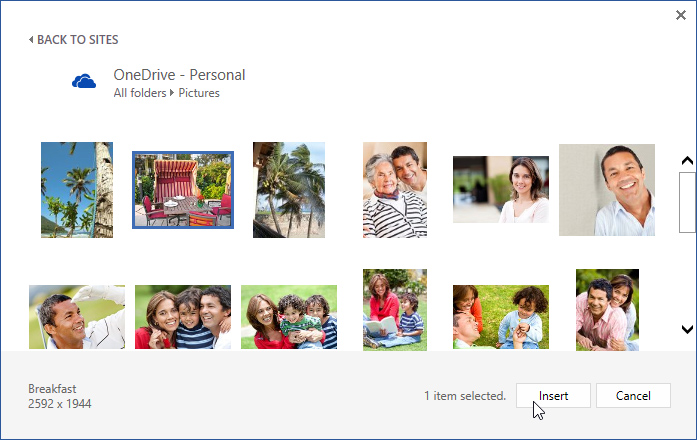 Office.com Clip Art results
Office.com Clip Art results - Bing Image Search: You can use this option to search the Internet for images. By default, Bing only shows images that are licensed under Creative Commons, which means you can use them for your own projects. However, you should go to the image's website to see if there are any restrictions on how it can be used.
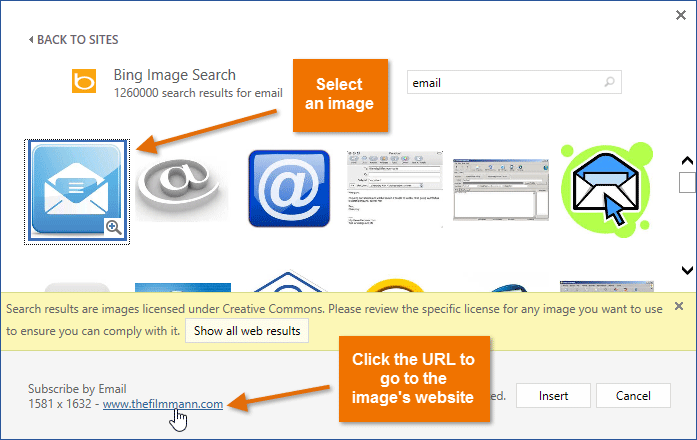 Bing Image search results
Bing Image search results
Previously, you also had the option to insert clip art images from Office.com, but this service has been discontinued. Instead, you can use Bing Image Search to find images for your document.
To insert an online picture:
- Place the insertion point where you want the image to appear.
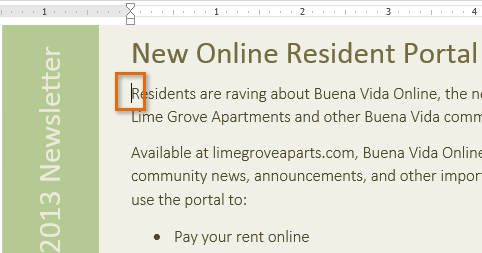 Placing the insertion point
Placing the insertion point - Select the Insert tab, then click the Online Pictures command.
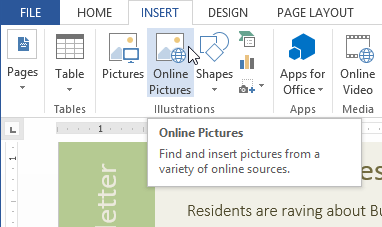 Clicking the Online Pictures command
Clicking the Online Pictures command - The Insert Pictures dialog box will appear.
- Choose Bing Image Search or your OneDrive. In our example, we'll use Bing Image Search.
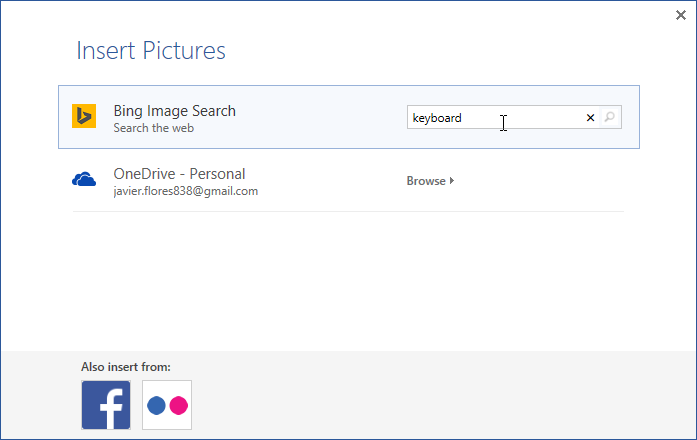 Typing a search term
Typing a search term
- Press the Enter key. Your search results will appear in the dialog box.
- Select the desired image, then click Insert.
 Inserting a search result
Inserting a search result - The image will appear in the document.
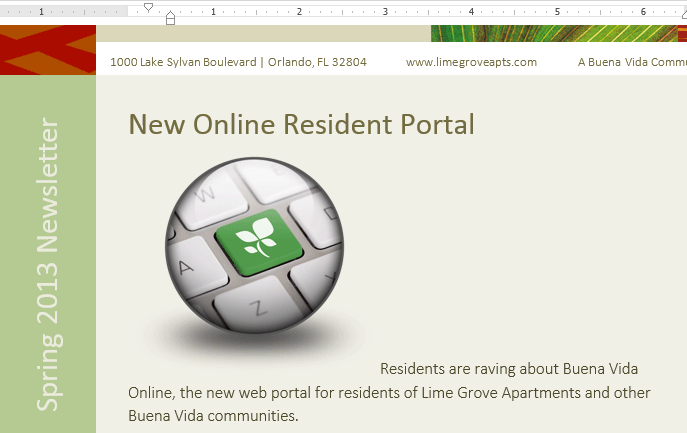 The inserted clip art
The inserted clip art
When adding images, videos, or music to your own projects, it's important to make sure you have the legal right to use them. Most things you buy or download online are protected by copyright, which means you may not be allowed to use them. For more information, visit our Copyright and Fair Use lesson.
Changing text wrapping settings
When you insert an image, you may notice that it's difficult to move it exactly where you want. This is because by default the image is in line with the text. If you want to move the image freely, you'll usually need to choose a different text wrapping setting. The text wrapping for an image is set to In Line with Text. You'll need to change the text-wrapping setting if you want to move the image freely or if you want the text to wrap around the image in a more natural way.
To wrap text around an image:
- Select the image you want to wrap text around. The Format tab will appear on the right side of the Ribbon.
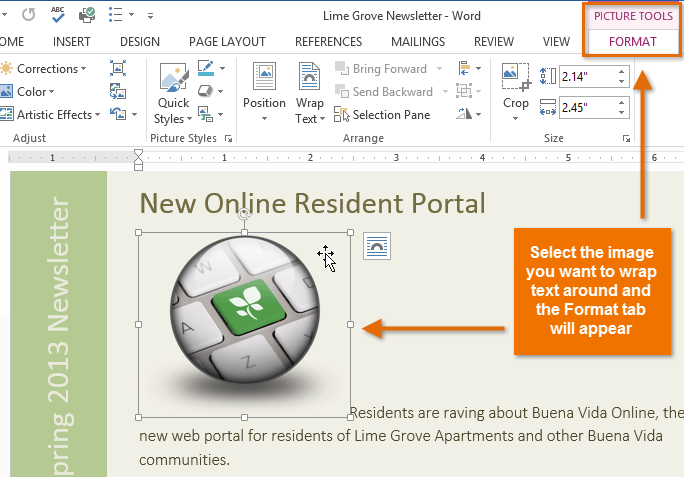 Selecting an image
Selecting an image - On the Format tab, click the Wrap Text command in the Arrange group. A drop-down menu will appear.
- Hover the mouse over the various text-wrapping options. A live preview of the text wrapping will appear in the document. When you've found the text-wrapping option you want to use, click it. Alternatively, you can select More Layout Options... to fine tune the layout.
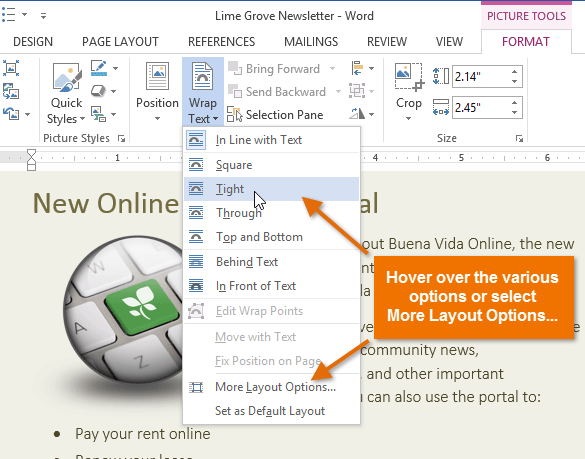 Selecting a text wrapping setting
Selecting a text wrapping setting - The text will wrap around the image. You can now move the image if you want. Just click, hold, and drag it to the desired location. As you move it, alignment guides will appear to help you align the image on the page.
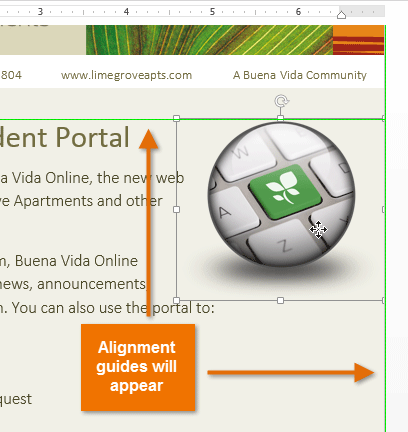 Alignment guides
Alignment guides
Alternatively, you can access text-wrapping options by selecting the image and clicking the Layout Options button that appears.
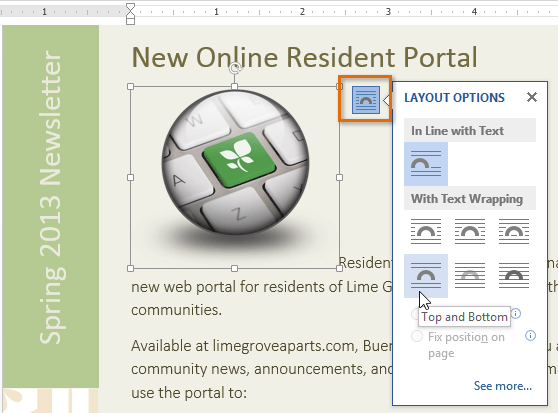 The Layout Options menu
The Layout Options menuIf the alignment guides do not appear, select the Page Layout tab, then click the Align command. Select Use Alignment Guides from the drop-down menu that appears.
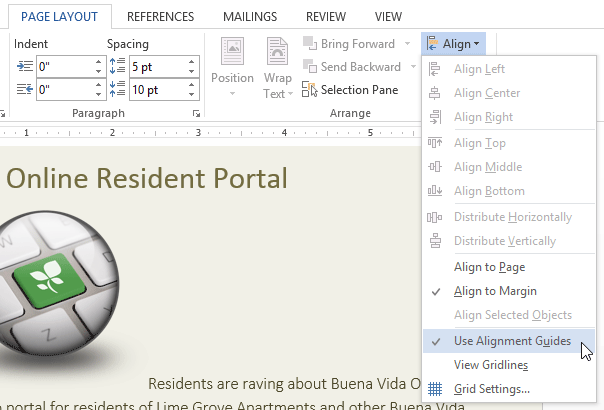 Turning on the alignment guides
Turning on the alignment guidesTo use a predefined text wrapping setting:
Predefined text wrapping allows you to move the image to a specific location on the page.
- Select the image you want to move. The Format tab will appear on the right side of the Ribbon.
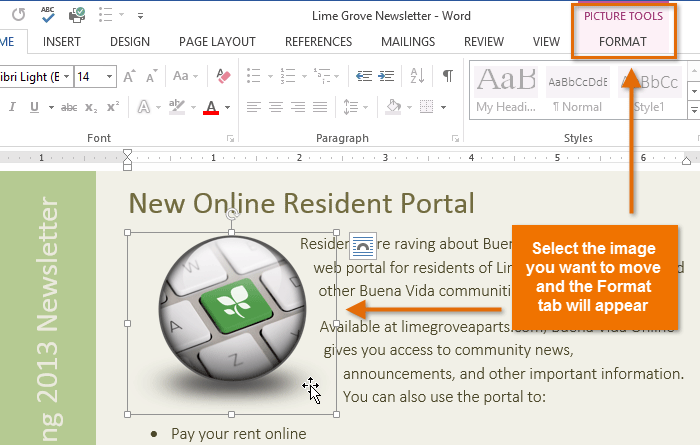 Selecting an image
Selecting an image - On the Format tab, click the Position command in the Arrange group.
- A drop-down menu of predefined image positions will appear. Select the desired image position. The image will adjust in the document, and the text will wrap around it.
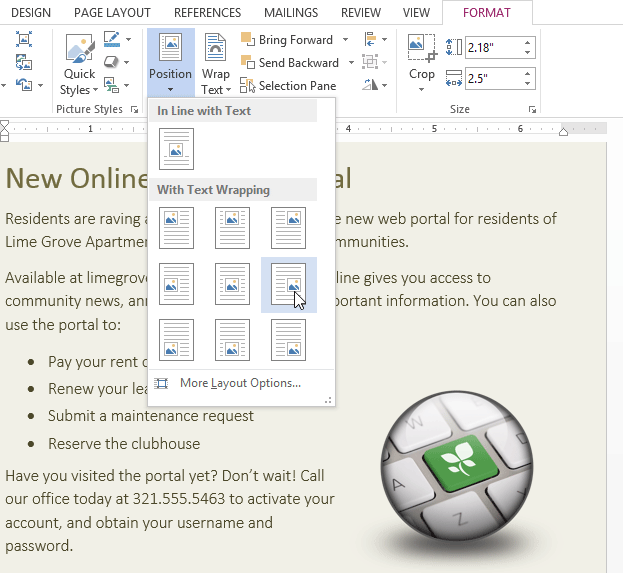 Selecting a text wrapping setting
Selecting a text wrapping setting
Challenge!
- Create a new Word document. If you want, you can use our practice document.
- Insert a picture from a file into the document.
- Resize the picture.
- Find a picture with Bing Image Search and insert it into your document. If you are using the example, search for computer and insert it in the New Online Resident Portal section.
- Change the text-wrapping setting of one of the images. If you're using the example, change the text-wrapping setting of the computer to Through.
- Try moving an image to a new location.
/en/word2013/formatting-pictures/content/


 Placing the insertion point
Placing the insertion point Clicking the Pictures command
Clicking the Pictures command Selecting a picture to insert
Selecting a picture to insert The inserted image
The inserted image . The image will change size while keeping the same proportions. If you want to stretch it horizontally or vertically, you can use the side sizing handles
. The image will change size while keeping the same proportions. If you want to stretch it horizontally or vertically, you can use the side sizing handles  .
. Resizing an image
Resizing an image Office.com Clip Art results
Office.com Clip Art results Bing Image search results
Bing Image search results Placing the insertion point
Placing the insertion point Clicking the Online Pictures command
Clicking the Online Pictures command Typing a search term
Typing a search term Inserting a search result
Inserting a search result The inserted clip art
The inserted clip art Selecting an image
Selecting an image Selecting a text wrapping setting
Selecting a text wrapping setting Alignment guides
Alignment guides The Layout Options menu
The Layout Options menu Turning on the alignment guides
Turning on the alignment guides Selecting an image
Selecting an image Selecting a text wrapping setting
Selecting a text wrapping setting